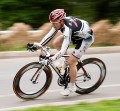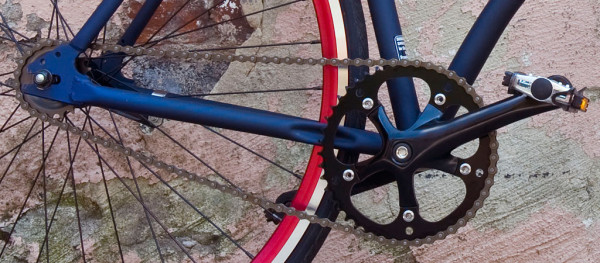By Todd Scheske, PCG Elite/Master Coach
Winter training can mean very different things depending on what part of the country you’re in. Here in the northeast we have cold, snow, ice, and more cold. Those factors often make roads challenging to train on, and the cold temperatures present a number of other challenges, especially when trying to log enough base endurance miles to prepare for spring racing. There’s always the option of a stationary trainer, but trying to ride all the hours needed indoors can result in a mental meltdown by March or April.
To solve these dilemmas, or at least minimize their effects, many years ago I adopted riding a fixed gear bicycle in the winter. Not a single-speed (an important distinction); a fixed gear. There is no coasting on a fixed gear bicycle, ever. When the rear wheel is turning on a fixed gear bicycle, so are your legs. A single-speed allows you to coast just like a road bike; your gear choice is simply limited to one. The fixed gear keeps you pedaling the entire time you’re moving.
There are some valuable advantages of the fixed gear over single-speed, road, mountain, and cross bikes. Fixed gear riding improves pedal technique, leg strength, and power, all while keeping you warmer! Click through for more on these great benefits…
You cannot effectively ride a fixed gear bicycle in undulating terrain without having (or developing) a smoother pedal stroke. If you’re accustomed to stomping the pedals instead of pedaling in flowing circles, the fixed gear will push you through those dead spots and will immediately correct you if you stop pedaling. On undulating terrain it forces you to apply increased pedal force on ascents, spin a much higher cadence, and spin smoothly on descents. If you aren’t smooth, you’ll start to bounce on the saddle and feel out of control, so it will take some focus at first to remain smooth and to apply force to the pedals all the way around. This higher, smoother rpm will add a lot of snap and efficiency to your pedaling. After a few months of endurance rides, you should see a significant improvement in the number of rpm you can turn and the snap you can generate from a small gear. It is also helpful to include a few town line sprints on your endurance rides, which will add to the high rpm work and teach you to sit, move as smoothly as you can, and drive the pedals forward at all times.
All this constant force and the variable, high-rpm pedaling in a small gear keep you warmer because you are constantly generating force on the pedals and your overall speed is lower than coasting on a road bike. I’m always amazed at how much colder I get in the spring once I’m back on the road bike, even in comparable temperatures.
So what do you need to get started with fixed gear training? If you don’t have one, buy an old track frame, or even an older-style road frame with horizontal dropouts and a fixed-hub rear wheel. You’ll need some room to adjust the chain tension, so a modern vertical dropout frame won’t work very well as a winter fixie. If you’re a do-it-yourselfer, Sheldon Brown offers some excellent information on making your own fixed gear bicycle on his website, sheldonbrown.com/fixed.html, along with links to even more information.
Next, figure out a gear that you can ride in a variety of terrains, keeping in mind that you’ll be riding into headwinds at times. I have found that 65-70 road inches (something around a 42×17, 39×16 gearing) works well; I can get up almost any climb with a bit of effort, cruise the flats, spin fast enough on the descents, and stay with a group ride.
I also like to add fenders to my winter fixie to keep my feet and the backs of my legs dry when the roads are wet with snow. I recommend that you do the same, because it greatly extends the time you can spend on the fixed gear by saving you from heading back inside with frozen feet. The fixie with fenders is also very low maintenance, since there are few parts collecting winter road crud and rust. A simple spray-off and some chain lube, and your bike is ready to go again. I rode one of my fixed gear bikes for nineteen winters before it wore out!
The fixed gear winter bike is inexpensive and simple, and it will add a lot to your winter endurance. You’ll pedal at least 10% more on a fixed gear bike than on a road bike. This means that you probably need to start out with shorter rides until you adapt to the constant pedaling. Also, if you haven’t had a good fitting done on your bike, get one now. Both of these are very important, as there is no bail-out if you start to experience pain from poor bike fit or lack of adaptation.
A few other tips to make your winter fixed gear riding more effective: tape off the bottom of the pedals to prevent wind coming up through the cleat bolt holes, duct tape any mesh toes on shoes, use heavier tread tires, consider Tuffy liners (or similar), and always carry a wrench for wheel removal in case of a puncture. Lastly, toss the chain come spring; it will rust into a solid chunk of metal by next fall.
Stay warm and enjoy the ride!
 Todd Scheske is a USA Cycling Level 1 coach and a category 1 cyclist. He has won several masters national medals, state road championships, and regional victories. Over the past twenty years he founded four different elite cycling teams and served as their program director and team director, while also promoting bike safety and healthy lifestyles to youth in community programs. He runs a successful junior program and produces a USA Cycling Talent ID camp. Todd can be contacted directly through www.PeaksCoachingGroup.com.
Todd Scheske is a USA Cycling Level 1 coach and a category 1 cyclist. He has won several masters national medals, state road championships, and regional victories. Over the past twenty years he founded four different elite cycling teams and served as their program director and team director, while also promoting bike safety and healthy lifestyles to youth in community programs. He runs a successful junior program and produces a USA Cycling Talent ID camp. Todd can be contacted directly through www.PeaksCoachingGroup.com.
Photo credit: frankinstienbikeworx.com

